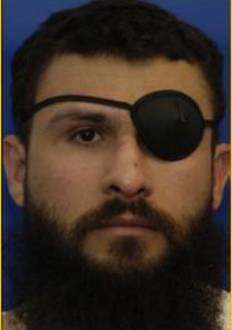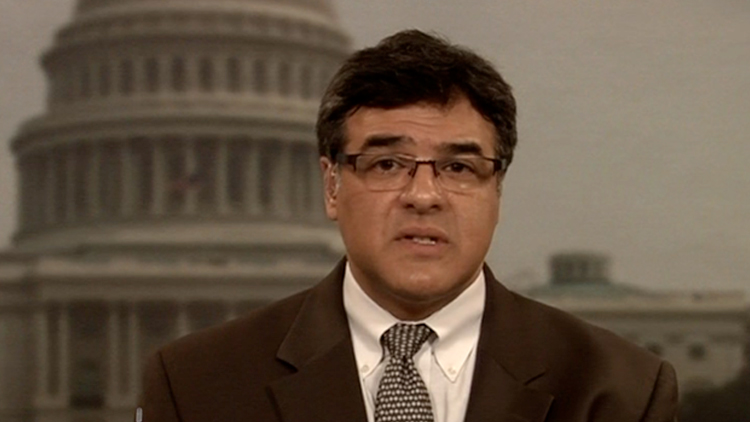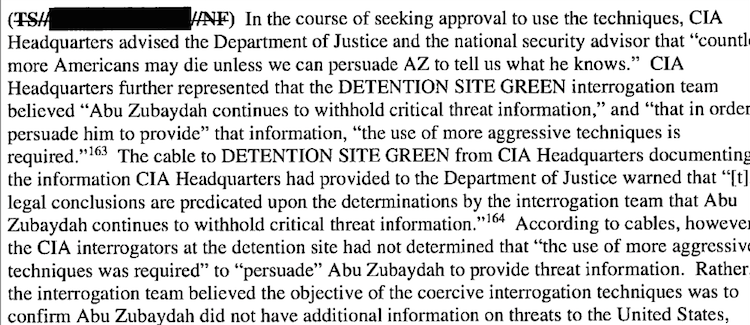In March 2002, Pakistani police stormed a building in Faisalabad, a bustling city about 120 miles south of Lahore, and were immediately met by gunfire.
The target was an al-Qaeda safe house, presumed to be harboring suspected terrorist Abu Zubaydah, whom American intelligence officials had essentially been hunting since the Sept. 11, 2001 attacks.
The CIA and FBI were the lead agencies, but Pakistani police were the first inside the safe house. They knew their suspicions were correct when, upon entering the building, a Pakistani officer was stabbed. The armed attacker was Zubaydah.
The bloody altercation provided Zubaydah enough of a distraction for him to flee to the roof. Once there, he became involved in a firefight with police. Zubaydah, who the CIA suspected of having close ties to Osama bin Laden, was struck several times by an AK-47.
Zubaydah was eventually transferred to a military hospital in Lahore, where the CIA and FBI kept him under 24/7 surveillance. This was a big moment for the American intelligence apparatus, and Zubaydah’s capture would become more than a footnote in CIA history. He was the first high-level al-Qaeda operative apprehended in America’s nascent war on terror—and the CIA had special plans for him.
Keeping watch was CIA officer John Kiriakou, who according to previous statements he made to the media, was the first man to interview the alleged terrorist.
This March will be the 13th anniversary of Zubaydah’s capture. Both men, if they take time to reflect on that day, will do so from behind bars: Zubaydah in Guantanamo Bay, Cuba, and Kiriakou, in a federal correctional facility in Pennsylvania.
In 2007, Kiriakou, after he had retired from the CIA, sat down with ABC News correspondent Brian Ross and described in great detail the operation that led to Zubaydah’s capture—two other safe houses were simultaneously hit that day, he said—the gunfight, and the alleged terrorist’s request that Kiriakou “smother him with a pillow.” In English, he told Kiriakou that “9/11 was necessary” and was supposed to serve a “wake-up call.”
It was during that interview that Kiriakou became the first person with personal knowledge of the CIA’s enhanced interrogation program to publicly reveal that the agency waterboarded its detainees. It was within 24 hours of that interview, Kiriakou told the independent news program Democracy Now, that the US government filed a criminal report against him—the first of a half-dozen.
But now for the first time, the CIA’s enhanced interrogation program, cloaked from public view, is available for all to see: The recently released Senate Intelligence Committee’s report details the methods that were used and what if any information was divulged as a result. The committee’s five-year review of the CIA’s post-9/11 secretive detention and interrogation program under President George W. Bush concluded that it was ineffective, deeply flawed and “far more brutal” than government officials were led to believe. Zubaydah was the first to undergo the harsh interrogation methods. He was the government’s guinea pig. But even before the Senate Intelligence Committee started its review, it was Kiriakou who publicly confirmed that such tactics, including waterboarding, had been employed.
“I suppose I can say…that my understanding is what’s been reported in the press has been correct in that these enhanced techniques included everything from what was called an attention shake where you grab the person by their lapels and [shake] them, all the way up to the other end, which was waterboarding,” Kiriakou told ABC.
Five years later, Kiriakou became the subject of a five-count federal indictment, though none of the counts were related to his divulging that the CIA engaged in waterboarding and other enhanced interrogation techniques in the ABC News interview. His supporters, however, believe Kiriakou became a target after he blew the whistle on the agency’s top-secret program that day.
Guinea Pig
Six days after Sept. 11, President George W. Bush signed a covert action memorandum that granted the CIA “unprecedented counterterrorism authorities, including the authority to covertly capture and detain individuals” who pose a threat to the US, according to the Senate report.
A CIA review concluded that US military bases were the best option to covertly hold detainees, but that would mean detainees would have to be declared to the International Committee of the Red Cross. The CIA’s position changed after Zubaydah’s capture. Instead, Bush approved a CIA proposal to hold Zubaydah at a black site based in another country that the report doesn’t identify.
 Before Zubaydah’s removal, he expressed a desire to cooperate with the FBI, according to the report. On April 10, 2002, inside the hospital’s intensive care unit, he provided FBI agents the name of a man named “Mukhtar,” who he said was the mastermind of 9/11. The FBI produced a copy of its Most Wanted List. Zubaydah identified “Mukhtar” as Khalid Shaykh Mohammad (KSM). Mohammad, Zubaydah told the FBI, trained 9/11 hijackers and was in charge of al Qaeda’s operations outside of Afghanistan. Those in the Senate who conducted the review said their findings refute claims by the CIA that Zubaydah gave up KSM only when he was forced to undergo enhanced interrogation.
Before Zubaydah’s removal, he expressed a desire to cooperate with the FBI, according to the report. On April 10, 2002, inside the hospital’s intensive care unit, he provided FBI agents the name of a man named “Mukhtar,” who he said was the mastermind of 9/11. The FBI produced a copy of its Most Wanted List. Zubaydah identified “Mukhtar” as Khalid Shaykh Mohammad (KSM). Mohammad, Zubaydah told the FBI, trained 9/11 hijackers and was in charge of al Qaeda’s operations outside of Afghanistan. Those in the Senate who conducted the review said their findings refute claims by the CIA that Zubaydah gave up KSM only when he was forced to undergo enhanced interrogation.
Two days later, George Tenet, the then-director of Central Intelligence, received this update on CIA’s interrogation plans for Zubaydah, according to the report:
“Our [CIA] lead interrogator will require Abu Zubaydah to reveal the most sensitive secret he knows we are seeking; if he dissembles or diverts the conversation, the interview will stop and resume at a later time…. In accordance with the strategy, and with concurrence from FBI Headquarters, the two on-site FBI agents will no longer directly participate in the interview/debriefing sessions.”
FBI special agents who had interviewed the suspect objected, according to the Senate report:
“AZ’s health has improved over the last two days and Agency [CIA] is ready to move [Abu Zubaydah] out of the hospital and back to [redacted] on [redacted] in an elaborate plan to change AZ’s environment. Agency [CIA] advised this day that they will be immediately changing tactics in all future AZ interviews by having only there [sic] [CIA officer] interact with AZ (there will be no FBI presence in interview room). This change contradicts all conversations had to date…. They believe AZ is offering, ‘throw away information’ and holding back from providing threat information (It should be note [sic] that we have obtained critical information regarding AZ thus far and have now got him speaking about threat information, albeit from his hospital bed and not [an] appropriate interview environment for full follow-up (due to his health). Suddenly the psychiatric team here wants AZ to only interact with their [CIA officer, and the CIA sees this] as being the best way to get the threat information…. We offered several compromise solutions… all suggestions were immediately declined without further discussion…. This again is quite odd as all information obtained from AZ has come from FBI lead interviewers and questioning…. I have spent an un-calculable amount of hours at [Abu Zubaydah’s] bedside assisting with medical help, holding his hand and comforting hum through various medical procedures, even assisting him in going [to] the bathroom…. We have built tremendous report [sic] with AZ and now that we are on the eve of ‘regular” interviews to get threat information, we have been ‘written out’ of future interviews.”
The CIA took over interviewing Zubaydah on April 13. During a meeting with Zubaydah inside the hospital room that lasted 11 minutes, a CIA officer told Zubaydah that he “had a most important secret [the interrogator] needed to know,” apparently related to future attacks on the US. He told Zubaydah to “signal” for him when he was ready to talk. He never did. FBI agents believed valuable time was being wasted.
On April 15, Zubaydah was told “time is running out.” That same day he was sedated and transported to a secret detention site—a windowless white cell. His interrogators blasted loud music to disorient him. Zubaydah was often kept naked.
Zubaydah had not fully recovered from his bullet wounds, so the CIA briefly reversed course. On April 17, an FBI agent was allowed to meet with Zubaydah for six hours, in which he denied knowledge of threats against the US. But he did continue to provide information about KSM and other terrorists in Pakistan, according to the report. On April 20, he told the FBI that he was approached by two men who desired to detonate a uranium-based explosive in the US, but “he did not believe the plan was viable.” He didn’t know the names of the pair, according to the report, but he was able to provide a description of the men he had encountered.
The CIA, however, believed Zubaydah was still hiding something. Zubaydah was held in isolation for 47 days between June and August of that year. During this time, a department within the CIA (its name is redacted from the report) drafted a letter stating that “the use of more aggressive methods is required to persuade Abu Zubaydah to provide the critical information we need to safeguard lives of innumerable innocent men, women and children within the United States and abroad.” It’s unclear if the attorney general ever received the letter, according to the report.
Officials continued to discuss potential interrogation methods and even went as far as to suggest what would become of Zubaydah’s body if he were to die during the interrogation. “He would be cremated,” according to a US government cable quoted in the report.
Two psychologists for the US Air Force were brought in to help implement the interrogation methods. Waterboarding, they suggested, would be an appropriate technique to stop Zubaydah from resisting.
On July 24, the attorney general verbally approved 10 interrogation techniques, including stress positions and sleep deprivation. Waterboarding was approved two days later. CIA records obtained by Senate staffers note that President Bush did not receive his first CIA briefing on the interrogation techniques until April 8, 2006—nearly four years later.
The CIA now had the approval they sought in order to more aggressively interrogate Zubaydah. From Aug. 4, 2002 through Aug. 23, 2002, Zubaydah received harsher interrogation methods on a “near 24-hour-per-day basis,” according to the Senate report. The initial techniques ranged from slamming Zubaydah against a concrete wall, threatening him with a large confinement box that when placed on the floor resembled a coffin, and slapped him every time he denied having information. He was waterboarded for the first time at 6:20 p.m. on Aug. 4, according to the report. It went on for two and a half hours, sometimes resulting in involuntary spasms, coughing and vomiting.
On Aug. 9, the interrogation team told CIA headquarters that it was “unlikely” Zubaydah had “actionable new information about current threats against the United States,” according to the report. But officials at the CIA still believed that Zubaydah was withholding important information. The interrogations were to continue.
The Senate report, which is highly critical of the CIA’s enhanced interrogation program, notes that Zubaydah never divulged information about an impending terrorist attack, even as he was subjected to the harsh interrogation methods. The two psychologists, however, saw the methods used on Zubaydah as a success, not because they were able to acquire crucial information, but because interrogators were able to confirm he had none.
“Our goal was to reach the stage where we have broken any will or ability of subject to resist or deny providing us information (intelligence) to which he had access,” states a cable, cited in the report. “We additionally sought to bring subject to the point that we confidently assess that he does not/not possess undisclosed threat information, or intelligence that could prevent a terrorist event.”
Zubaydah was eventually handed over to the Department of Defense in September 2006.
Ex-CIA Agent Prosecuted
Kiriakou was three years removed from the CIA when he sat down for his now infamous interview with ABC News. The interview focused on the operation to apprehend Zubaydah, but quickly pivoted to interrogation methods that were being reported in the news media, most notably, waterboarding.
Kiriakou possessed vast knowledge about the CIA and the role it played following the attacks on the World Trade Center and the Pentagon. After serving as an analyst, he later became the chief of counterterrorism operations after 9/11. He resigned in 2004, later taking a position as a senior investigator for the Senate Foreign Relations Committee.
Ross, the ABC News correspondent, asked Kiriakou if he felt comfortable with the techniques.
“Frankly, no,” he responded. Kiriakou said he had declined to take part in the training after consulting a senior officer within the agency. Kiriakou, however, expressed the same feelings that many in the CIA did with regards to waterboarding: It was worth it, he told Ross. (Kiriakou’s position has changed since, and he’s become a critic of the technique.)
Ross then asked if he’d define waterboarding as torture. “You know, at the time, no,” Kiriakou said, explaining that he thought it was something the US needed to do at the time. But not any more.
“And at the time I felt that waterboarding was something that we needed to do,” he said. “And as time passed, and as Sept. 11 has…moved farther and farther back into history, I think I’ve changed my mind. And I think waterboarding is probably something that we shouldn’t be in the business of doing.”
“Why do you say that now?” asked Ross.
“Because we’re Americans,” Kiriakou responded, “and we’re better than that.”
On April 5, 2012, a grand jury in Alexandria, Va., indicted Kiriakou under the Espionage Act, a World War I-era law originally meant to prosecute spies, for identifying a covert agent and disclosing information to a journalist. (The name of one of the covert agents wasn’t published but the identity of the agent ended up in a classified defense filing before a military commission at Guantanamo Bay.) The grand jury also indicted Kiriakou on a fifth count for “willfully” concealing and covering up a classified investigative technique used in the Zubaydah mission that he wanted to include in his 2010 book The Reluctant Spy: My Secret Life in the CIA’s War on Terror.
Facing 45 years in prison, Kiriakou pleaded guilty to one count of violating the Intelligence Identities Protection Act for revealing the identity of a covert officer to a journalist. He was sentenced to 30 months in prison.
Before the plea deal, Kiriakou’s attorneys argued in its motion to dismiss counts one through four that the prosecution was engaging in “selective prosecution,” and that Kiriakou was being punished for embarrassing the government by publicly revealing that it had engaged in torture.
“Because of Kiriakou’s earlier statements, which did not violate any laws, the government has seized upon the current allegations of improper disclosures to prosecute him, even though numerous other individuals that have communicated the same or similar information have not faced prosecution,” his lawyers wrote, according to court documents in the case.
His attorneys cited several examples of what they deem to be government-approved leaks. The first was a New Yorker magazine article detailing the raid that killed Osama bin Laden in which the author stated that he knew the identities of the Navy Seals that conducted the operation. Also cited in the motion is a New York Times article describing a US cyber attack to disrupt Iranian nuclear facility, which quotes sources inside the White House Situation Room.
“The one common element among these unprosecuted leaks is that they portray the government in an excellent light,” his attorneys write in the motion. “Contrast this with the information offered by Kiriakou in his 2007 interview, which contradicted the narrative that the United States did not engage in the torture of prisoners, his even more embarrassing statement in 2009 that waterboarding was not even effective, and his work investigating the intelligence coverage of a volatile region of the world for the Senate Foreign Relations Committee. The only logical conclusion to be drawn from these facts is that the government has tolerated other disclosures because they resulted in press favorable to the government. But when Kiriakou allegedly made illegal disclosures of exactly the same nature, government officials found a reason to punish him for his past candor.”
Former CIA officer John Kiriakou refused to torture, refused not to expose it and is in prison for doing so. #TortureReport
— John Kiriakou (@JohnKiriakou) December 9, 2014
Prosecutors, in their 31-page response, denied that their motivation for prosecuting Kiriakou was because of past comments about torture.
“The Department of Justice has never filed criminal charges against him in connection with any of these matters,” it said.
“Now seeking to adopt the ill-fitting mantle of whistleblower,” prosecutors added, “defendant asserts that his statements about these and other subjects improperly motivate the prosecution against him.”
The complaint, prosecutors insist, “has nothing to do with waterboarding, the national conversation about its wrongness or rightness, the defendant’s opinions, or other public statements he may or may not have made.”
Kiriakou pleaded guilty to the single count on October 2012. He was sentenced on Jan. 25, 2013, and entered the Federal Correctional Institution in Loretto, Penn., on February 28, 2013.
Since the release of the Senate’s so-called torture report, a number of human rights groups have called for the architects of the program to be prosecuted. Recently the American Civil Liberties Union and Human Rights Watch sent a letter to outgoing Attorney General Eric Holder calling on him to appoint a special prosecutor to investigate “the crimes” detailed in the Senate report.
They weren’t alone. The New York Times published an editorial Monday headlined, “Prosecute Tortures and their Bosses.” And they named names:
“But any credible investigation should include former Vice President Dick Cheney; Mr. Cheney’s chief of staff, David Addington; the former C.I.A. director George Tenet; and John Yoo and Jay Bybee, the Office of Legal Counsel lawyers who drafted what became known as the torture memos,” the Times editorial board wrote on Dec. 22. “There are many more names that could be considered, including Jose Rodriguez Jr., the C.I.A. official who ordered the destruction of the videotapes; the psychologists who devised the torture regimen; and the C.I.A. employees who carried out that regimen.”
Additionally, the European Center for Constitutional and Human Rights, a human rights group in Berlin, Germany, recently filed a criminal complaint against the US torture program’s architects, accusing several George W. Bush administration officials of war crimes.
Yet, as of now, the only person with knowledge of the enhanced interrogation program to be prosecuted is Kiriakou—and that’s for crimes unrelated to the actual torture of the detainees.
For those crimes, Kiriakou is sitting in a low-security prison along with 1,216 inmates in western Pennsylvania.




































